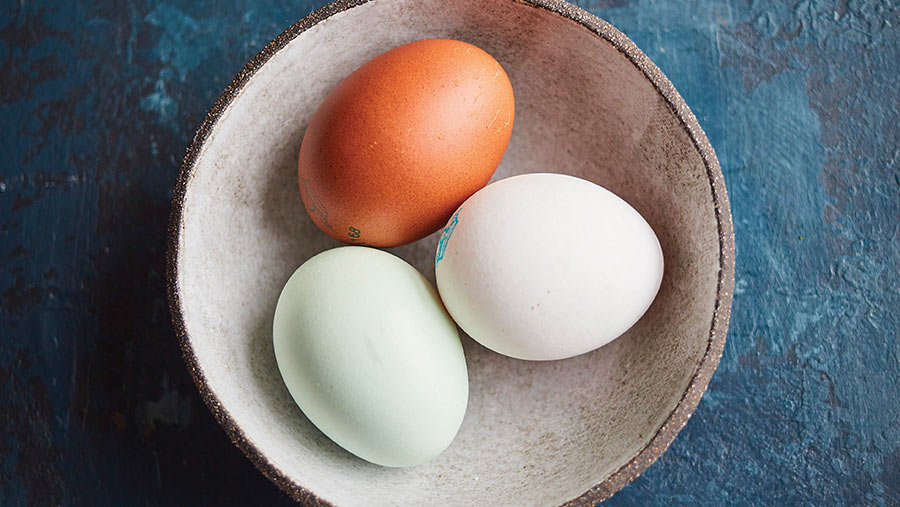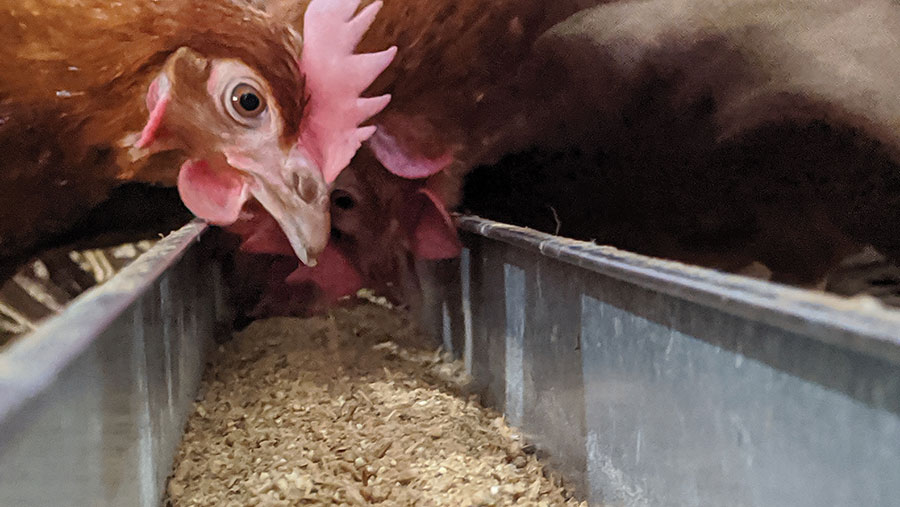Expert advice on moving into free-range shell egg production
 © Wynnstay
© Wynnstay The free-range shell egg market includes brown, white and speciality eggs, all of which have unique challenges and opportunities when it comes to optimising profitability.
The market is in long-term growth, with increasing numbers of welfare-conscious consumers choosing free-range eggs.
Adding value starts with identifying the right target market. This depends on a number of factors, including the existing farm system.
In addition, farmers with certified organic land will be well-placed to partner with a top-end supermarket, such as Waitrose or Sainsbury’s, that sell organic eggs.
Producers can then access the premium prices that come with organic production, especially if they sell to a packer that can help market the eggs.
See also: How to take free-range layers to 100 weeks
What’s the difference between shell types?
- White eggs More likely to be used in catering because they are less popular in the retail market, which is driven by customer preference for brown-shelled eggs
- Brown eggs The most popular choice for shoppers who perceive them to be a more natural product compared with white-shelled eggs
- Speciality eggs Eggs like the pastel-blue Legbar make a premium due to an association with traditional farming methods
Regardless of the end market, Tom Willings, supply chain director at Stonegate, advises producers to look closely at the contract with their egg packer, paying particular attention to the terms and conditions.
“It’s important to understand what happens in changing circumstances, like when egg or raw material prices fluctuate, as this can impact profitability long term.
“Once contracts are agreed, making shell eggs pay – whatever the end market – depends on farming with close attention to detail,” he adds.
Mr Willings and Jim Turner, head of poultry at Wynnstay, share their views on how producers can cut costs and add value to make the most from their flocks.
Speciality eggs
For producers of speciality eggs, success is all about accessing the premium value by meeting the high production standards.
Producers must first understand the additional scrutiny that comes with supplying eggs for a brand, including the requirement for faultless record keeping, says Mr Willings.
Each speciality breed must have the right shell and yolk colour, egg size and shell quality. But, more importantly, producers must adopt the highest welfare standards because this is why the end customer is choosing a specialty egg and paying a premium for it.
For example, Burford Browns will not produce as many eggs as a commercial hybrid, because they are not selected for optimum feed conversion.
However, if provided with the right conditions and quality feed that contains sufficient fibre to support gut health, and calcium to support the frame of the bird, the hens will lay [more eggs?]. Producers can then benefit from the premium price.
Troubleshooting tips
Mr Willings recommends spending as much time as possible with the speciality flock to help identify any problems, such as birds laying on the floor.
Floor eggs are immediately downgraded to processing, which means farmers miss out on the premium prices.
Therefore, spotting an increase in floor eggs – and implementing changes to prevent this – can help optimise profits for that flock. Mr Turner agrees that close monitoring of factors such as temperature, light and consumption of feed and water can help with understanding and reducing production costs.
“Speciality breeds are more robust than commercial hybrids, but they do benefit from a constant optimum temperature, usually between 19C and 21C,” he says.
“Being too hot reduces their feed consumption, which, in turn, reduces egg size. Investing in improvements to ventilation, to ensure an inflow of clean air while maintaining temperature at the optimum level for the breed, can make a real difference over time, for example.”
Speciality egg pointers
- Additional scrutiny from buyers
- Egg production may be lower
- Higher quality feed will offset lower egg yield
- Tweak management to avoid floor eggs
- Invest in better climate control to maximise feed intake
Brown eggs
Making standard brown eggs pay requires a different approach, as it is all about focusing on efficiencies and economies of scale.
“Producers must aim to keep input costs as low as possible, while maximising the output,” says Mr Turner.
“This is more achievable with larger flocks, which is why 64,000-bird flocks are becoming increasingly common, as it is possible for the packer’s lorry to be sent to just one place for collection.”
Choosing an end market and selecting the right breed to meet requirements and specifications is the number-one way to save unnecessary costs.
In the UK, there’s greater customer demand for large shell eggs.
Producers looking to meet this demand should pay close attention to the figures in the breed target books, and choose accordingly.
“Trying to produce large eggs with birds that are genetically optimised to produce medium eggs is like fighting an uphill battle; it will definitely increase production costs with limited results.”
Minimising waste
Mr Turner also recommends reducing waste wherever possible, and adopting a feed strategy to ensure the right feed is given in the right quantity, at the right time.
Early morning feed is essential, because it is important for the birds to take in feed as soon as possible after waking.
But feeding too frequently – so the birds don’t get to the bottom of feed in the tracks – can reduce overall intake and increase waste. This is because the birds end up eating too many of the chunky bits of feed on top, but not enough powdery bits underneath, which are full of amino acids.

© Wynnstay
Mr Turner says there is also an opportunity to save on labour costs by allowing feed to run down while the birds are laying.
This avoids the birds being distracted by the noise of the feed tracks running, which can entice them to leave nest boxes to eat.
Birds then lay in the feed area and staff are required to spend extra time collecting eggs from the floor and feeder system.
Brown egg pointers
- Costs must be minimised
- Larger flocks have better economies of scale
- Choose a breed capable of producer large eggs
- Feed early morning
- Avoid feeding too frequently to reduce waste
White eggs
Mr Turner says there are significant cost-saving opportunities with white birds, because they have better liveability and their overall egg output is higher.
The average brown bird flock lays for 72-76 weeks, while white bird flocks lay for 90-100 weeks. This means that after three flocks of white birds, a producer can save the investment of an entire flock, which is about £130,000 for a 32,000-bird flock, plus turnaround costs.
White birds also display less behavioural issues, such as feather pecking. This allows improved feed efficiency as birds will not compensate for feather loss with higher feed intake.
“A slightly weird cost saving is that white birds are somewhat reflective within the shed, meaning the lights can be dimmer, saving electricity costs,” he says.
Egg production rates
White breeds only lay medium eggs, so they cannot meet the demand for large free-range eggs.
The price received for white eggs is also lower. However, each bird can lay 500 eggs in 100 weeks, compared with a brown flock which typically lays 320 eggs a bird in 72 weeks.
White egg pointers
- Significant cost savings are possible
- Birds lay for longer – 90-100 weeks
- Egg production is higher
- Fewer feather-pecking issues
- Birds cope with lower light conditions
- Only medium egg sizes are possible
Brown, white and speciality egg production and costs compared |
|||
| Production | Brown | White | Speciality |
| Eggs (each bird a lay) | 330 | 470 | 285 |
| Lay (weeks) | 74 | 91 | 74 |
| Pullet costs (£ a bird) | 4.50 | 4.50 | 5.80 |
| Average feed cost (£/t) | 245 | 245 | 255 |
| Consumption (kg a bird) | 49 | 60 | 49 |
| Miscellaneous costs (£ a bird) | 5.50 | 6.50 | 5.50 |
| Average farmgate price (£/dozen) | 0.85 | 0.80 | 1.15 |
